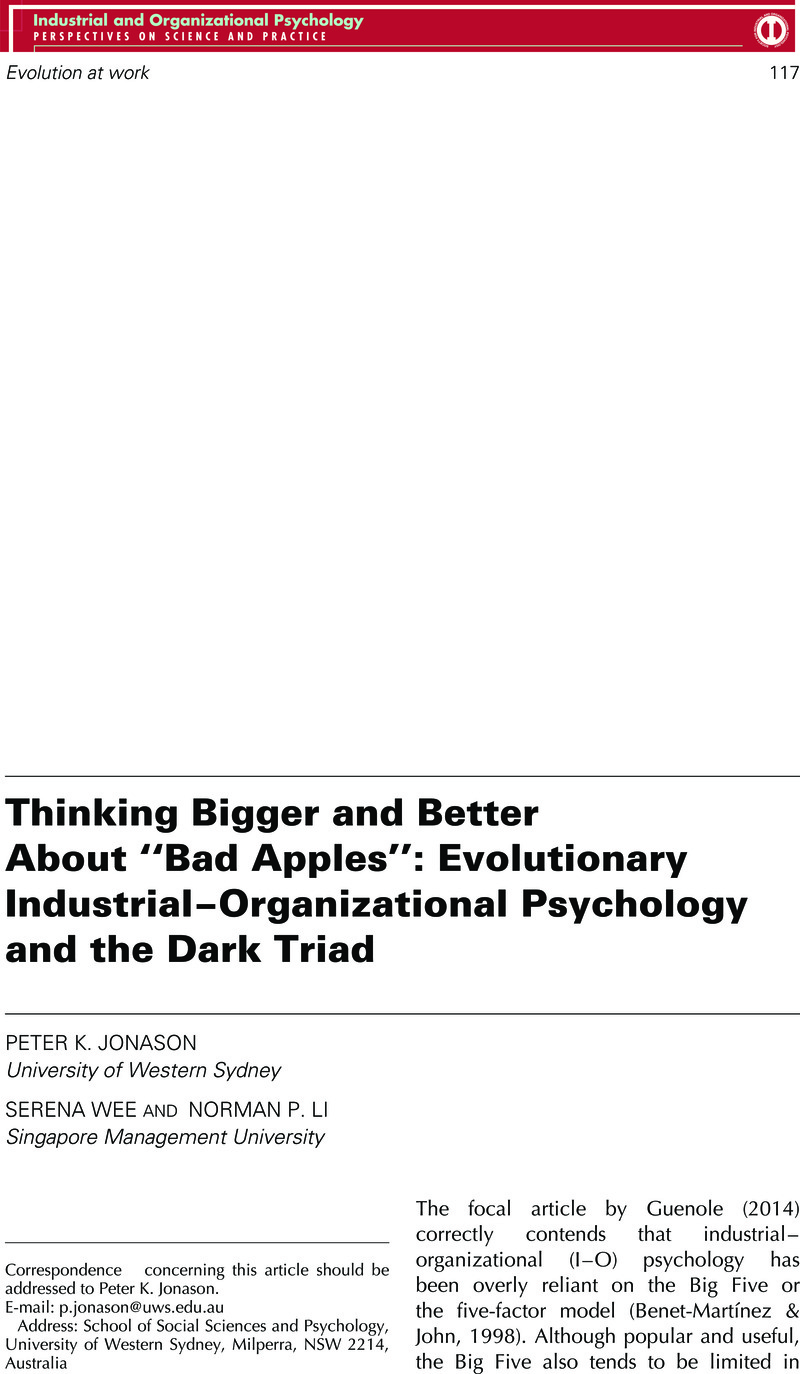Crossref Citations
This article has been cited by the following publications. This list is generated based on data provided by Crossref.
Jonason, Peter K.
Wee, Serena
Li, Norman P.
and
Jackson, Christopher
2014.
Occupational niches and the Dark Triad traits.
Personality and Individual Differences,
Vol. 69,
Issue. ,
p.
119.
Jonason, Peter K.
Wee, Serena
and
Li, Norman P.
2015.
Competition, autonomy, and prestige: Mechanisms through which the Dark Triad predict job satisfaction.
Personality and Individual Differences,
Vol. 72,
Issue. ,
p.
112.
Schyns, Birgit
2015.
Dark Personality in the Workplace: Introduction to the Special Issue.
Applied Psychology,
Vol. 64,
Issue. 1,
p.
1.
Robertson, Stephen A.
Datu, Jesus Alfonso D.
Brawley, Alice M.
Pury, Cynthia L.S.
and
Mateo, Niño Jose
2016.
The Dark Triad and social behavior: The influence of self-construal and power distance.
Personality and Individual Differences,
Vol. 98,
Issue. ,
p.
69.
Castille, Christopher M.
Kuyumcu, Daniel
and
Bennett, Rebecca J.
2017.
Prevailing to the peers' detriment: Organizational constraints motivate Machiavellians to undermine their peers.
Personality and Individual Differences,
Vol. 104,
Issue. ,
p.
29.
Jonason, Peter K.
and
O'Connor, Peter J.
2017.
Cutting corners at work: An individual differences perspective.
Personality and Individual Differences,
Vol. 107,
Issue. ,
p.
146.
Palmer, Joshua C.
Komarraju, Meera
Carter, Min Z.
and
Karau, Steven J.
2017.
Angel on one shoulder: Can perceived organizational support moderate the relationship between the Dark Triad traits and counterproductive work behavior?.
Personality and Individual Differences,
Vol. 110,
Issue. ,
p.
31.
Wissing, Benno G.
and
Reinhard, Marc-André
2017.
The Dark Triad and the PID-5 Maladaptive Personality Traits: Accuracy, Confidence and Response Bias in Judgments of Veracity.
Frontiers in Psychology,
Vol. 8,
Issue. ,
Costa, Hilda
2018.
Encyclopedia of Evolutionary Psychological Science.
p.
1.
Externbrink, Kai
and
Keil, Moritz
2018.
Narzissmus, Machiavellismus und Psychopathie in Organisationen.
p.
19.
Paleczek, Dominik
Bergner, Sabine
and
Rybnicek, Robert
2018.
Predicting career success: is the dark side of personality worth considering?.
Journal of Managerial Psychology,
Vol. 33,
Issue. 6,
p.
437.
LeBreton, James M.
Shiverdecker, Levi K.
and
Grimaldi, Elizabeth M.
2018.
The Dark Triad and Workplace Behavior.
Annual Review of Organizational Psychology and Organizational Behavior,
Vol. 5,
Issue. 1,
p.
387.
Wissing, Benno Gerrit
and
Reinhard, Marc-André
2019.
The Dark Triad and Deception Perceptions.
Frontiers in Psychology,
Vol. 10,
Issue. ,
Swab, R. Gabrielle
and
Johnson, Paul D.
2019.
Steel sharpens steel: A review of multilevel competition and competitiveness in organizations.
Journal of Organizational Behavior,
Vol. 40,
Issue. 2,
p.
147.
Conard, Maureen A.
2020.
Predicting Leader Emergence with Bright and Dark Traits.
The Journal of Psychology,
Vol. 154,
Issue. 1,
p.
1.
Costa, Hilda
2021.
Encyclopedia of Evolutionary Psychological Science.
p.
7382.
Cui, Zilong
and
Zhang, Kaixin
2021.
Dark Triad but a bright future? Socially malevolent personality traits and proactive career behavior.
Social Behavior and Personality: an international journal,
Vol. 49,
Issue. 11,
p.
1.
Zhang, Kaixin
and
Cui, Zilong
2022.
Are narcissists always bad apples? The relationship between employee narcissism and creative deviance.
Frontiers in Psychology,
Vol. 13,
Issue. ,
Dierdorff, Erich C.
and
Fisher, David M.
2022.
Problematic personalities in teams: Implications for performance trajectories and resilience to unexpected change.
Personnel Psychology,
Vol. 75,
Issue. 3,
p.
589.
Yong, Jose C.
Tan, Yi Wen
Li, Norman P.
and
Meltzer, Andrea L.
2022.
Looks and status are still essential: Testing the mate preference priority model with the profile‐based experimental paradigm.
Journal of Personality,
Vol. 90,
Issue. 6,
p.
821.





